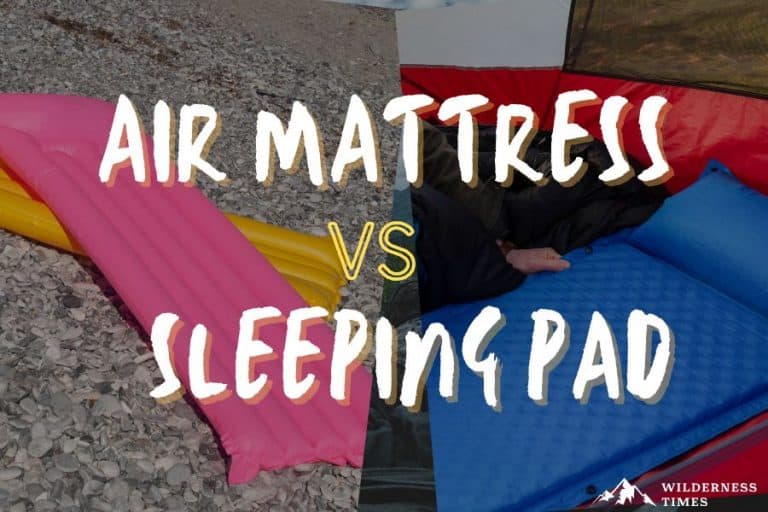When crafting the optimal camping sleep system, it’s common for people to get stuck when deciding between an air mattress versus a sleeping pad.
Avid campers will swear by their favorite method but truth be told, both have their benefits and drawbacks.
What it really comes down to is your own personal needs.
The air mattress vs. sleeping pad debate could go on forever. But we’re here to help you make the best decision for your camping needs!
Table of Contents
ToggleAir Mattress vs. Sleeping Pad
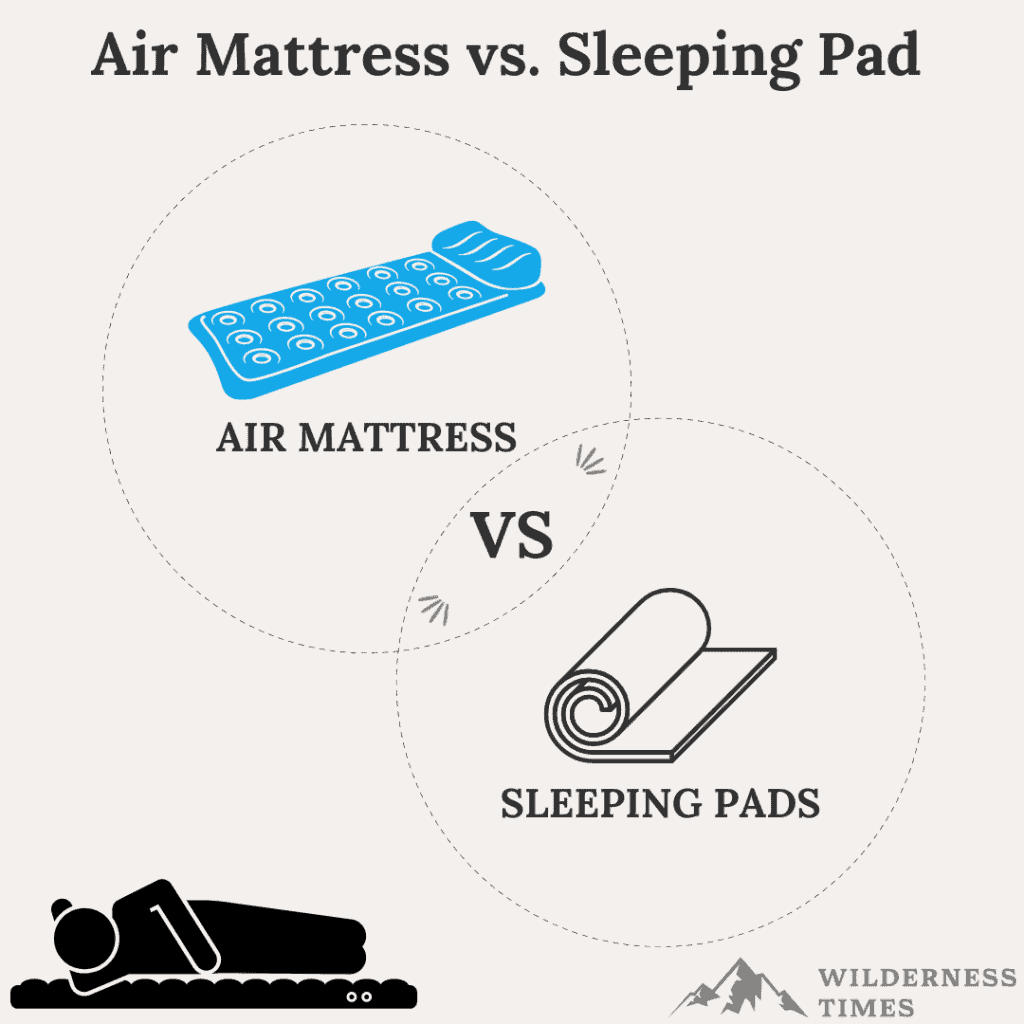
Choosing between an air mattress and a sleeping pad can be difficult. They both come with their own pros and cons.
But when it comes right down to it, choosing between an air mattress and a sleeping pad depends solely on your personal camping preferences and needs.
For instance, if you’re hiking to your campsite, you’ll want to go with something less bulky than an air mattress.
But, if you’re car camping, an air mattress might be the way to go if you’re looking to keep as many comforts of home as possible.
To determine where you stand on the sleeping pad vs. air mattress debate, first figure out how much room you’ll have for packing, how much room you’ll have for sleeping, how many people will you be accommodating, your budget, and most importantly, your comfort preferences.
Air Mattress vs. Sleeping Pad – A Quick Comparison
AIR MATTRESS | SLEEPING PAD | |
Warmth | ||
Comfort | ||
Portability | ||
Durability | ||
Ease of Use | ||
Value |
Air Mattress
An air mattress is an inflatable bed that you can blow up using your own breath or a pump.
When not in use, you simply let the air out and roll it up for storage.
Types of Air Mattresses
There are three types of air mattresses you can choose from when camping: raised, self-inflating, and adjustable/convertible air mattresses.
1. Raised Air Mattress
A raised air mattress is just that- raised! These kinds of air mattresses inflate to a height that is taller than your standard single-high air mattress of 10 inches.
This is beneficial because it can be more comfortable (read: more like your mattress back home!) and it keeps you higher off the ground (which is a plus when the ground is cold).
2. Self-Inflating Air Mattress
A self-inflating air mattress can be your best friend if you hate having to blow air mattresses up by hand or at your car.
They work via an internal pump that simply needs to be turned on with a button or a knob, or via a valve that sucks in air as the internal foam expands.
So there are no external parts you have to worry about losing!
These air mattresses are quick to setup but can cost more than a traditional air mattress.
3. Adjustable/Convertible Air Mattress
If you’re willing to put a little more money into an air mattress, you can get a convertible air mattress that had adjustable settings!
These air mattresses allow you to control features such as firmness with just a remote control that will either release or add air for you.
Benefits of an Air Mattress
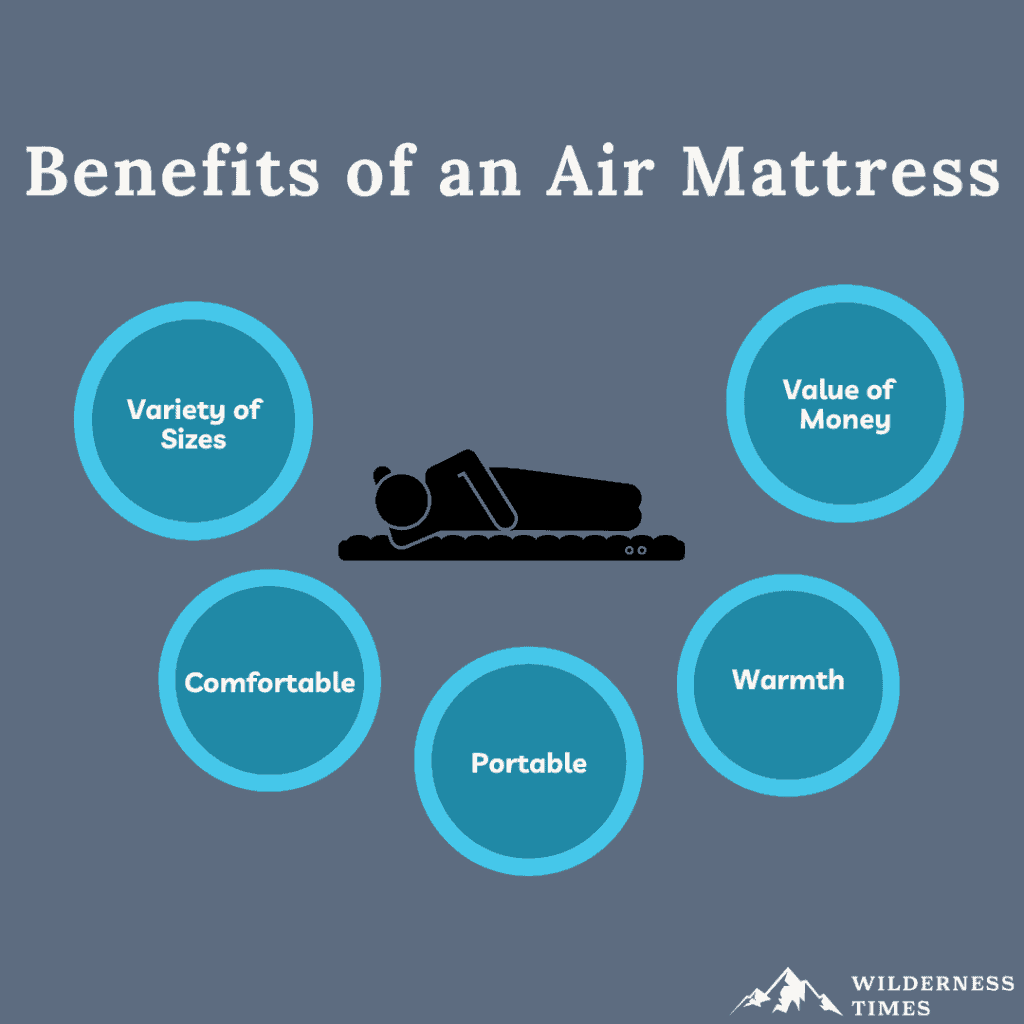
Air mattresses have a ton of benefits for camping, especially for anyone who wants to bring the comforts of home with them.
Variety of Sizes
Air mattresses come in a variety of sizes. From twin-sized to a queen air mattress, there are plenty of options available for whatever size you may need.
Whether you need to take up a small space or have an entire tent to take up space for comfort, there’s already an air mattress on the market to meet your needs.
Comfortable
An air mattress is the camping sleeping solution that is going to be the most like your mattress at home.
This means you might find it more comfortable than a sleeping pad.
Being off the ground thanks to the air inside the mattress, you won’t be feeling all the rough bumps and hard surface of the ground.
Plus, air mattresses give you more room to stretch out.
Portable
Air mattresses are extremely portable. When not inflated, an air mattress lies pretty flat.
This allows you to roll it up end to end and slide it into its carrying bag so you can throw it in with the rest of your gear.
All in all, when rolled up, an air mattress will only take up an area the size of a shoebox or smaller.
Warmth
While air mattresses might not give you the same insulation as a sleeping pad, you still get the benefit of warmth from not having to sleep on the cold, hard ground.
If camping in cold months with an air mattress, you’ll still want a zero degree sleeping bag, or some thermal blankets for optimal warmth.
Value of Your Money
Air mattresses are easy on your wallet! A simple basic twin-sized air mattress could be as cheap as $20.
Of course, you can always opt for an air mattress with added bells and whistles such as self-inflation or adjustable firmness.
But even with added features, air mattresses tend to be rather affordable.
Provides You With a Larger Sleeping Area
Instead of being stuck in the small space of a single sleeping area like you would with a sleeping bag, air mattresses typically give you much more room to spread out, roll around a bit, etc. giving you a much more comfortable night’s sleep.
Of course, you will still want to bring your sleeping bag (especially a good rectangular one), but in the summer it is entirely possible to get away without one if you it is warm enough at night.
This can also be beneficial when camping with multiple people, as it’s easier to bring double air mattresses that can pack down smaller than some sleeping pads.
Easy to Maintain
As long as you take care to store your air mattress properly, they are extremely easy to maintain.
Simply wash it off every now and then, and you’re good to go.
And if it eventually gets a hole in it, that is an easy maintenance procedure, as well!
Simply throwing an easy-to-use patch over the hole will make your air mattress as good as new in no time.
Drawbacks of Air Mattresses
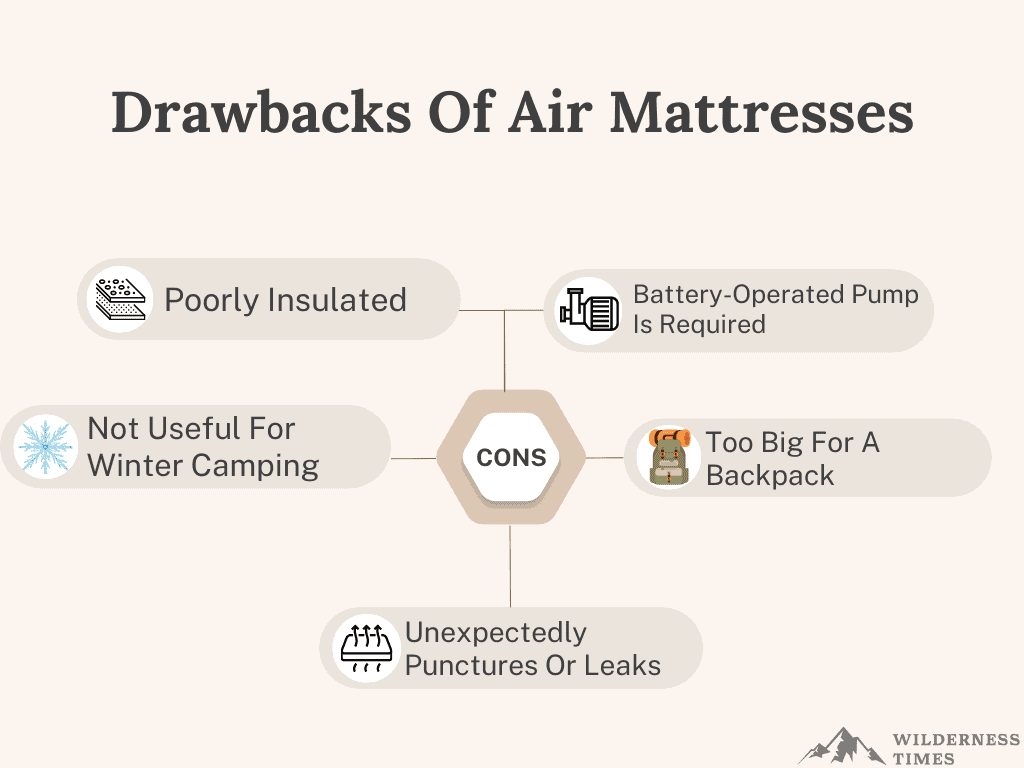
While air mattresses are wonderful at making you feel like you’re right at home, they can also be a major pain when you get down to the logistics of using one while camping.
Poorly Insulated
Air mattresses are essentially made up of plastic, which is not insulating in the least.
So when sleeping on an inflated air mattress, your body is heating the air inside but the mattress is not doing anything to help you retain the heat.
All of your body heat is going to the air inside the mattress, leaving you chilly.
Staying warm on an air mattress, especially in colder months, would require added gear such as a sleeping bag, or thermal blankets to help insulate you.
Not Useful for Winter Camping
As we just mentioned, air mattresses are poorly insulated and can leave you shivering, especially if it’s already cold outside.
Camping with an air mattress in the winter can be cold and frustrating if you’re not properly prepared as you’ll need more gear to stay warm and cozy in your sleep.
Unexpectedly Punctures or Leaks
One of the biggest downfalls of air mattresses are their ability to get punctured and start leaking.
Even if you take all the care in the world, ensuring your campsite is free of twigs and other debris that could poke a hole in your air mattress, it’s inevitable that it will begin to leak one day.
Whether from general wear and tear or a puncture hole, sleeping on a leaky air mattress is no fun, especially when you wake up to find yourself flat on the ground or sandwiched into your mattress like a taco.
Fixing a hole or leak in an air mattress might be as simple as slapping a patch overtop of the affected area. But it can still be a hassle.
Battery-Operated Pump is Required
Many air mattresses these days use a pump to inflate. Yes, there are still some that only require your own breath to inflate it, but who has the time or energy for that?
The downside to a pump-operated air mattress is that you usually need batteries or some other source of electric power to get it up and running, especially if you have a fancy air mattress that allows you to adjust the air and firmness with the touch of a button.
Finding an energy source to pump and maintain this type of air mattress might be difficult when camping.
Too Big for a Backpack
While air mattresses are super-portable, they aren’t necessarily small when deflated and rolled up. In fact, they are too big for a single backpack.
This can be a major pain point for anyone who is hiking to their camping destination and require packing as small as possible.
No one wants to sacrifice important gear and supplies like food just to save space for their air mattress.
How to Choose the Best Air Mattress For Camping
When picking out an air mattress for camping, you need to know how you will be using it before you start browsing.
Then, you can determine which of these features will suit your needs best.
Size
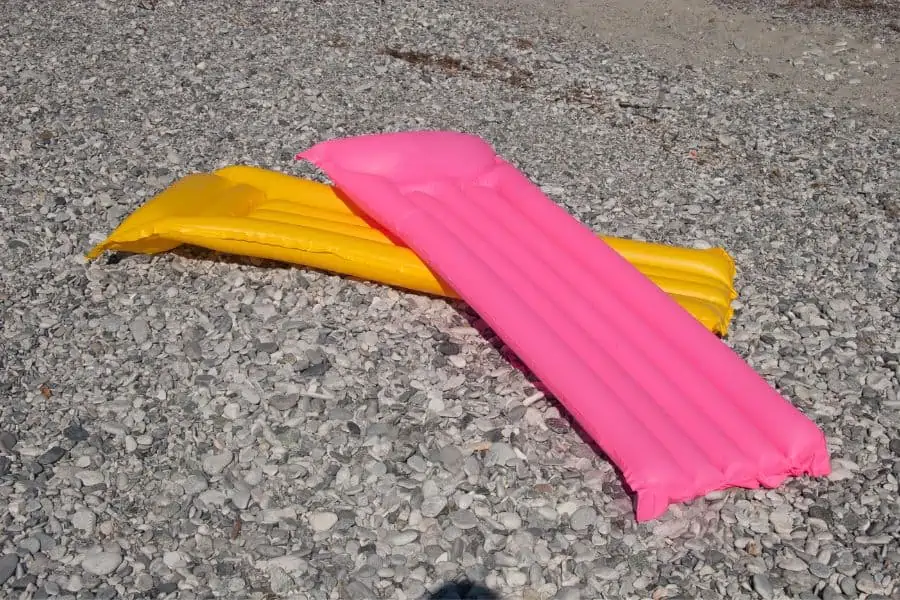
Since air mattresses are available in a wide variety of sizes, you won’t have any trouble finding one to meet your needs.
You just have to figure out what size to go with!
Have a small tent you don’t want to fill? Go with a twin-sized. Need plenty of leg room for a restless sleeper? Try a double. Sleeping with a partner? There’s always a queen.
Read: What Size Tent Fits A Queen Mattress?
Type
The type of air mattress that you want depends on what kind of comfort you are looking for.
If comfort isn’t a priority, a simple air mattress that uses a hand pump could suit you well.
However, if you want to ensure you get the best night’s sleep possible while camping, you could choose from raise, self-inflating, and adjustable air mattresses.
Don’t have the time to mess with inflation? Go with self-inflating. Want to be as far off the ground as possible? Go with raised.
Want to be able to control all of these elements depending on what you’re feeling in the moment? Go with adjustable.
Inflation and Deflation
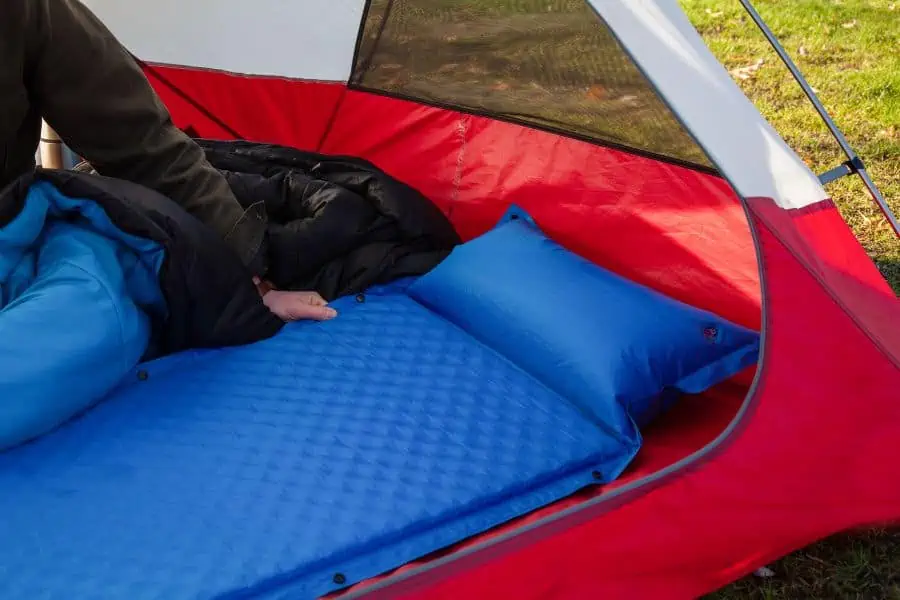
Knowing how much effort you are prepared to put into the inflation and deflation of the air mattress will also determine which one you should buy.
If you don’t have the time or energy to inflate an air mattress by hand, choose an air mattress that either self-inflates or inflates via an electric pump.
On the flip side, if you won’t have electricity, you’ll need a manual or self-inflating air mattress.
Deflation is pretty simple no matter the air matter, but some require a bit more time and effort than others.
For instance, if you choose a self-inflating air mattress that utilizes the foam method, you will need to physically roll the air out of the mattress, or else the air will continually be sucked in and it will be stuck inflated.
Pump

Air mattresses come with a wide variety of pumps. What you have available to inflate it coupled with your own preferences will tell you what kind of pump you need.
No source of electricity? You’ll need a manual or battery-powered pump.
Be sure to check batteries before you leave if this is the option you go with! Not looking for a lot of set-up work? You’ll probably want an electric pump or self-inflating air mattress.
Sleeping pad
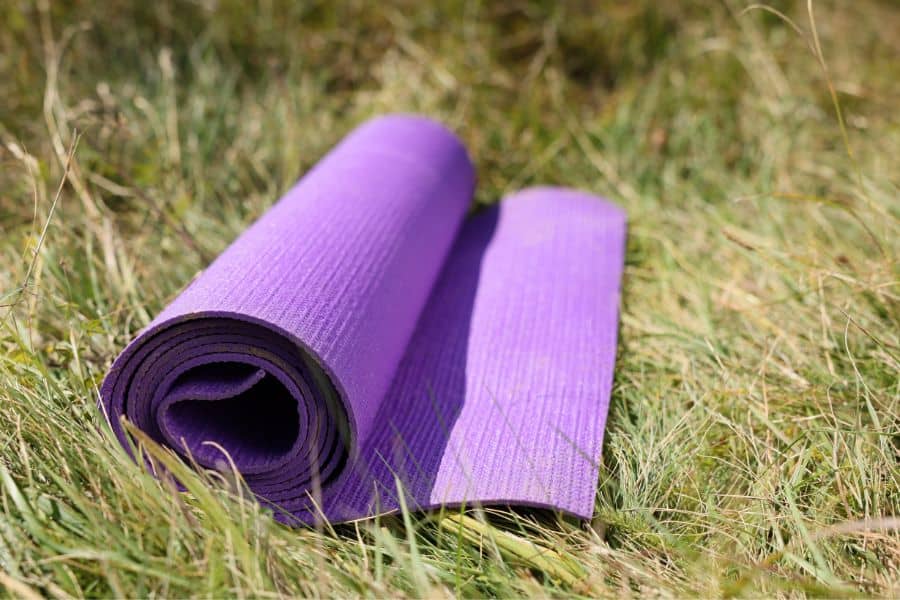
Sleeping pads are an essential part of any camping sleep system and are particularly useful for backpackers who want to pack small and light.
However, they are also great for layering with other items to create the best night’s sleep possible.
Types of Sleeping Pads
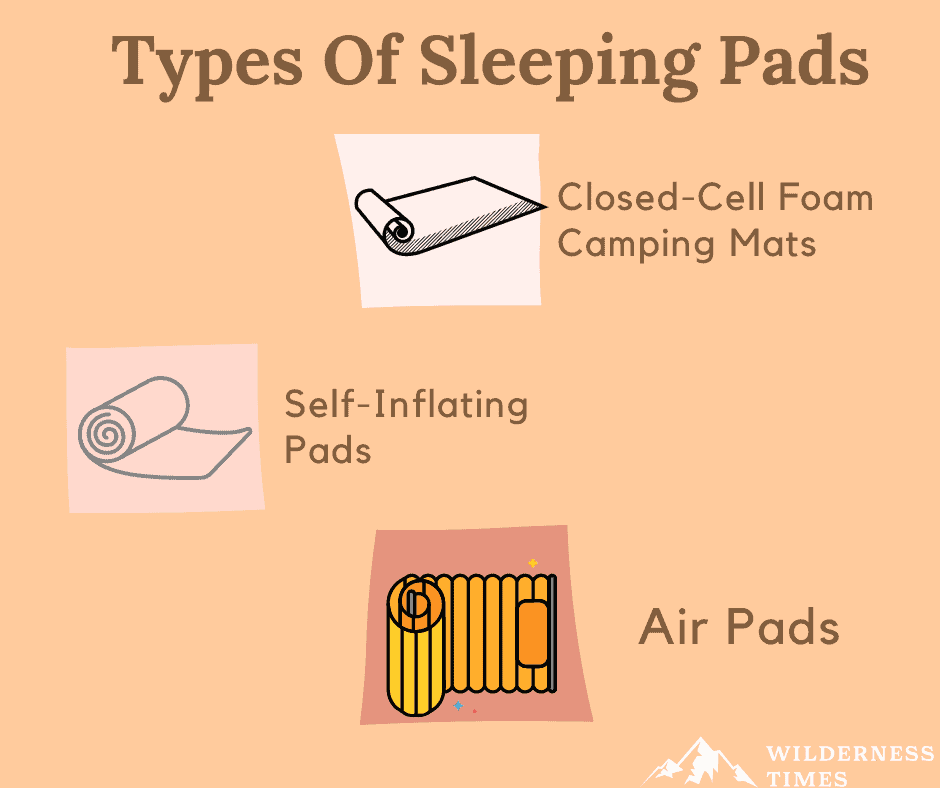
There are three types of sleeping pads you can choose from when camping: closed-cell foam, self-inflating, and air pads.
1. Closed-Cell Foam Camping Mats
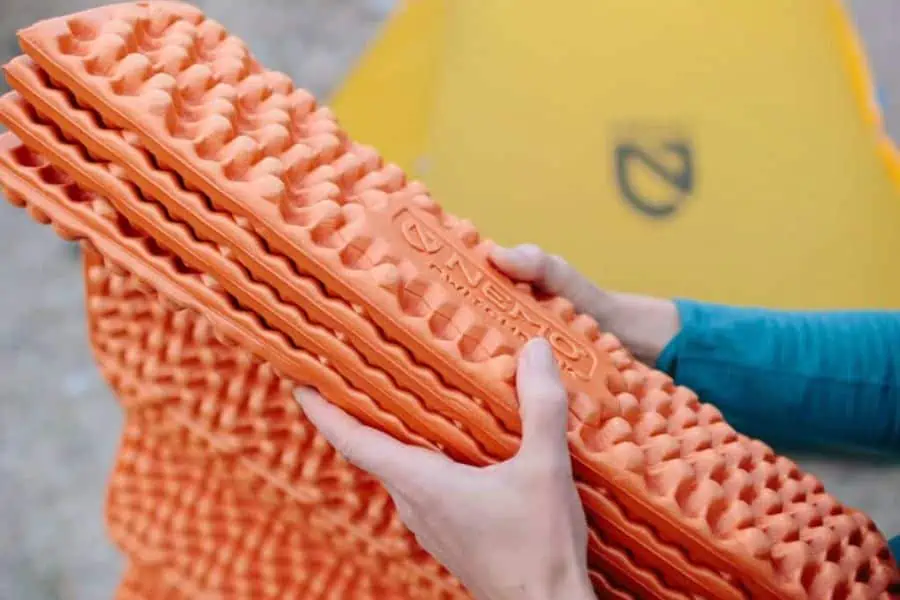
Closed-cell foam camping mats are made out of dense foam that is comprised of many small air cells.
All you need to do is roll it out and get to sleeping! There is no setup or inflation necessary for closed-cell foam camping mats.
These camping mats are lightweight, easy to pack, and can provide you with extra warmth and insulation.
However, they aren’t always the most comfortable sleeping arrangement as the foam is rather firm.
2. Self-Inflating Pads
Much like self-inflating air mattresses, self-inflating sleeping pads simply blow up on their own.
Using a combination of air and closed-cell foam padding, self-inflating pads have foam inside that starts to expand as soon as you open the valve to let the air enter.
The inflation process could take between five and ten minutes but is relatively straightforward and easy.
Some self-inflating pads are even small enough to pack when hiking, but not all.
The great part about self-inflating pads, is that they are sort a hybrid and can provide superior comfort and insulation over an air mattress.
3. Air Pads
Much like an air mattress, air pads are simply the size of a camping mat but filled with air.
Unlike self-inflating pads, you will need to inflate an air pad on your own. Some use hand pumps while others come with an electric pump installed.
These camping pads also do not come standard with insulation to help keep you warm. Some models do.
But the more basic air pads will simply be filled with air.
Benefits of Sleeping Pads
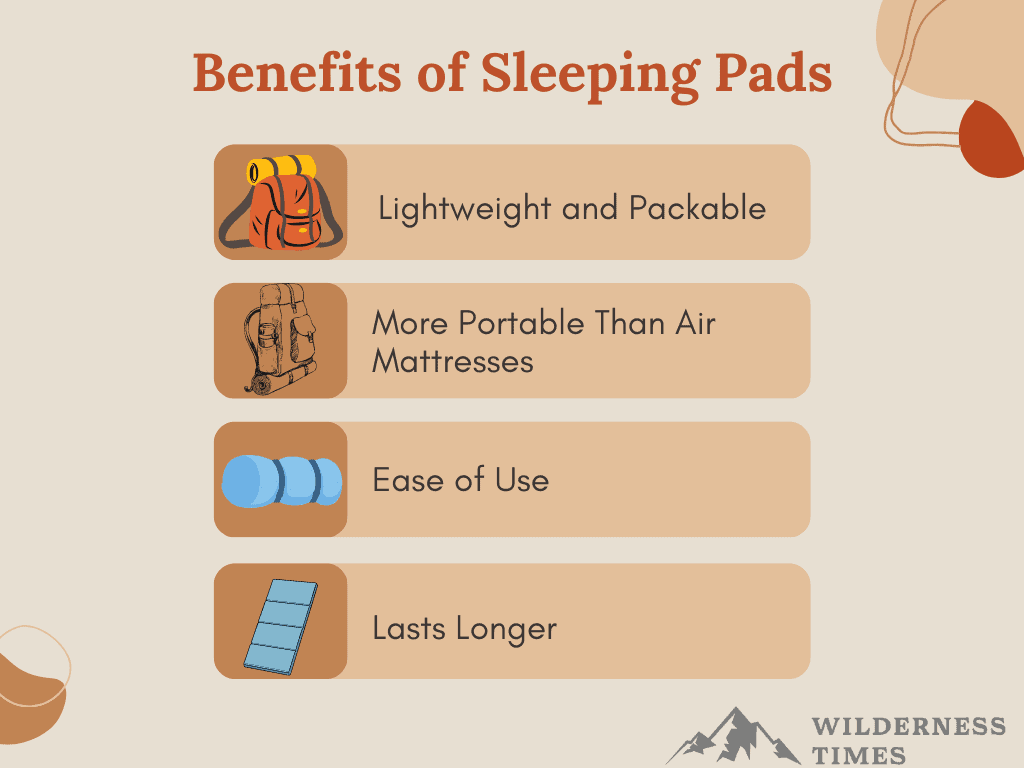
Sleeping pads can be a super beneficial piece of equipment to add to your arsenal of camping gear, especially if your main concern is portability.
Lightweight and Packable
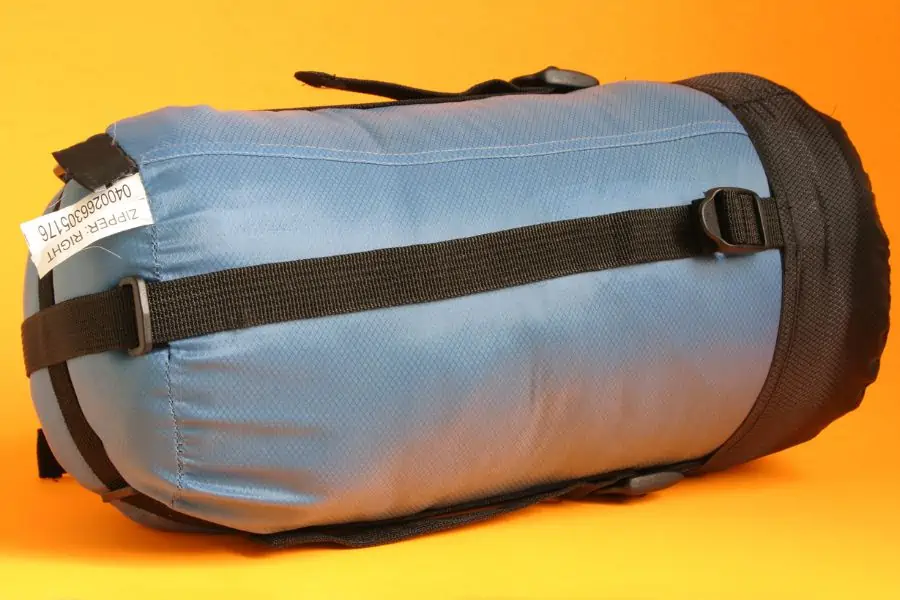
Sleeping pads are super lightweight and easy to pack, especially compared to air mattresses.
There isn’t as much bulk involved in their construction, so they are usually the first choice for anyone who is backpacking, hammock camping, or just needs to save space when packing.
Related: Best Sleeping Pad For Hammock Camping: Top 5 Reviewed
Provides Great Insulation
Where air mattresses can get chilly due to the lack of insulation, sleeping pads are made out of materials such as foam that provide much better insulation.
Sleeping pads are perfect for camping in colder months due to their insulation. They can keep you nice and warm even when it’s chilly outside.
More Portable Than Air Mattresses
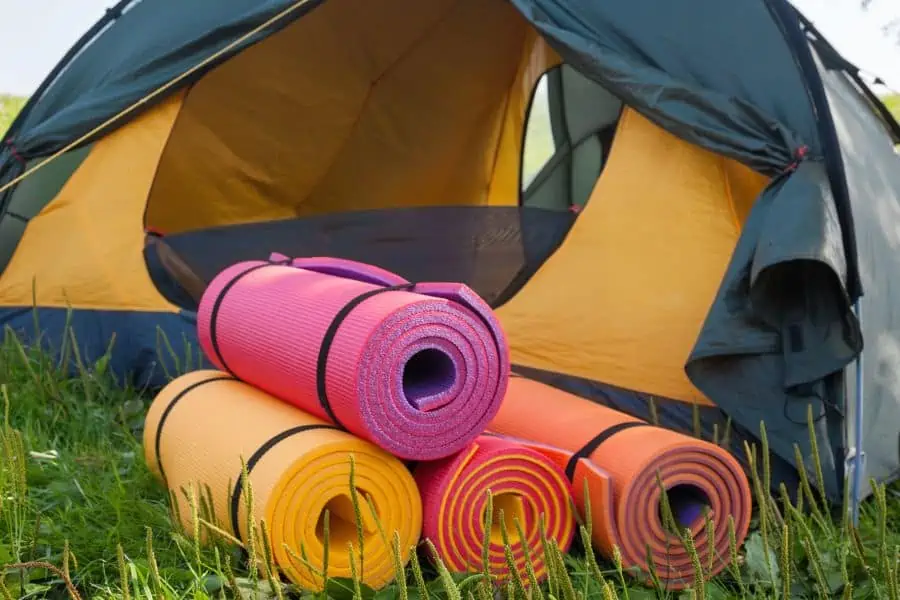
Air mattresses take up so much room, even when deflated and rolled up, that they are not ideal for backpacking. They would take up most of your packing space!
But sleeping pads are a different story. They take up much less space than an air mattress when they are rolled up and packed away.
They are also much lighter. So, you won’t be sacrificing space or comfortability if you go with a sleeping pad!
Related: Camping Storage Ideas
Ease of Use
Sleeping pads couldn’t be any easier to inflate, use, and then deflate. Most just need to be rolled out to use!
Closed-cell foam sleeping pads are already good to go once you roll them out. And self-inflating sleeping pads do all the work for you.
Air pads may take a little more work than either of the former options, but it’s still a quick setup!
Lasts Longer

Sleeping pads are very durable and tend to last longer than an air mattress.
Air mattresses get a lot of wear and tear between all the inflating and deflating. Plus, there’s the whole pesky puncture risk you always have to worry about.
With most sleeping pads, you don’t even have to worry about an accidental puncture! That means you will be using it for a very long time.
Drawbacks of Sleeping Pads
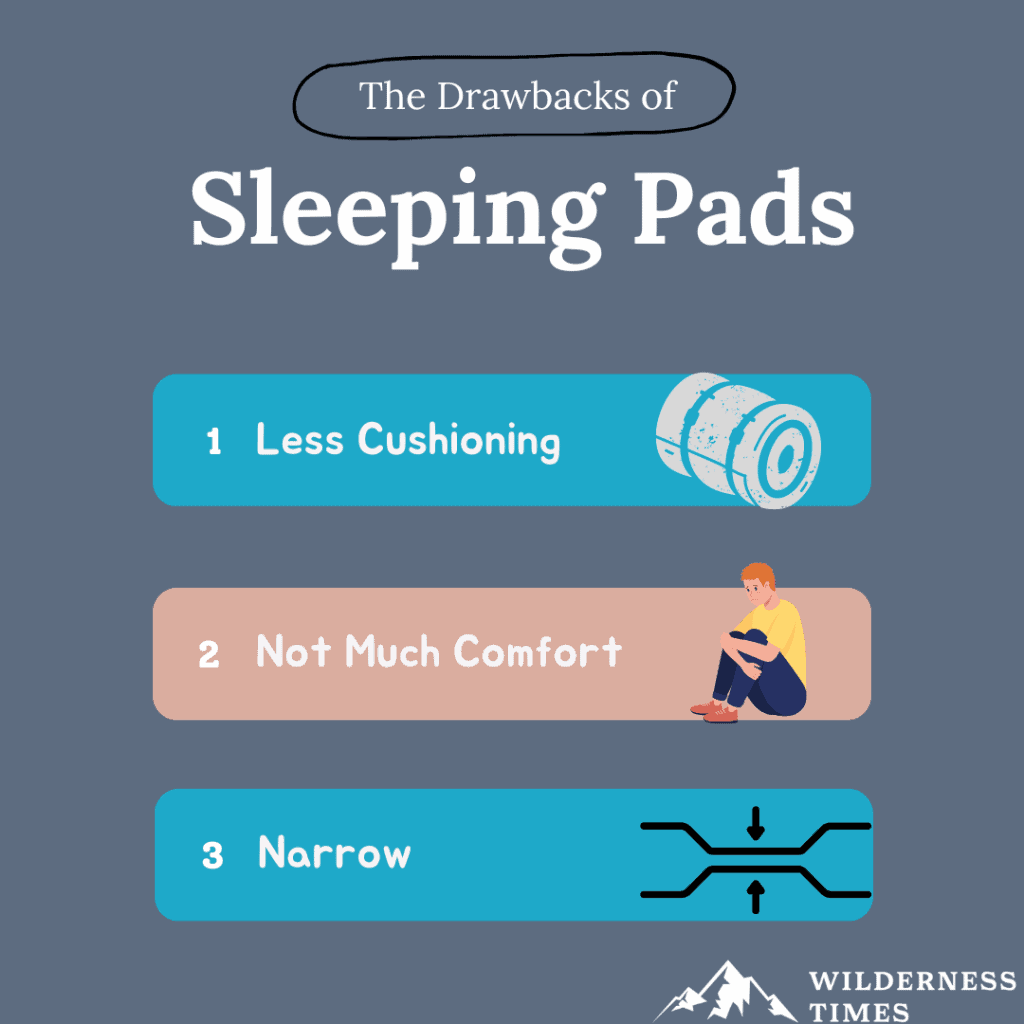
Sleeping pads can be great for saving space and time when setting up camp, but they also have their fair share of drawbacks, including not being the most comfortable night’s sleep.
Less Cushioning
Sleeping pads have significantly less cushioning than an air mattress. They are made out of denser material and are much thinner than an inflated air mattress, making you closer to the ground.
While this can benefit your camping packing, it can also be a drawback if you’re looking for comfort.
Not Much Comfort
Thanks to having less cushioning, sleeping pads are not as comfortable as an air mattress.
Air mattresses are the closest thing you get to the comforts of your bed back home when you are camping.
Since they are thinner and more dense, sleeping pads do not provide the same kind of comfort.
They are much more firm than an air mattress and leave you closer to the ground which is just as likely to make for an uncomfortable night’s sleep.
Narrow
It’s standard for sleeping pads to be rather narrow.
This means that it accommodates only one sleeper at a time and you would need to have one sleeping pad for every camper versus fitting multiple sleepers on an air mattress.
How to Choose the Best Sleeping Pad
When picking out a sleeping pad, you will need to have a good idea of how you will be using it and what your main concerns are when camping.
Weight
Sleeping pads in general are rather lightweight, but they can run from super lightweight to somewhat dense depending on which type you get.
Self-inflating sleeping pads are the heaviest kind of sleeping pads while closed-cell foam sleeping pads are the lightest.
If the weight of your sleeping pad is something that you need to be conscious of, this will help narrow down the type of sleeping pad you should get.
How Thick Should a Sleeping Pad Be?
The standard thickness for sleeping pads, especially for self-inflating and air pads, is about 2.5 inches.
Although, there are a ton of variations on the market that offer thinner or thicker pads.
Some air pads come as thick as 3 inches if you are looking for a little more cushion and some self-inflating sleeping pads come as thin as 1.5 inches to accommodate packing and hiking needs.
Not to mention, closed-cell foam sleeping pads tend to be 1 inch thick or less.
Packed Size
The average size of a packed, lightweight sleeping pad is about 9 x 4 inches rolled up, which is about the size of a large water bottle.
These are usually closed-cell foam sleeping pads or thin air pads.
If you’re going for a lightweight sleeping pad for backpacking, you could even find one that packs down to the size of a small, one-pound (16-ounce) package.
However, the foam sleeping pads would be a little denser.
Variations in sleeping pads would change their packed size, as well.
A larger sleeping pad with more cushion may weigh closer to 25 ounces and measure about 11 x 5 inches. These are usually self-inflating or air pads.
The largest size of sleeping pads rolls up to about 25-30 inches wide and weighs 3-5 pounds.
These are usually air pads and perfect for car campers or anyone looking for more comfort.
Insulation and R-Value
The R-Value of a sleeping pad is a measure of its insulation and warmth.
If you want the technical definition, it’s a “measure of thermal resistance, or the ability of heat to transfer from hot to cold, through materials.” R-Values are even used to rate home insulation.
When looking at sleeping pad R-Values, they will range anywhere from 1 to 10 with 1 being virtually no insulation and 10 being the most insulation possible.
Anything with an R-Value between 1 and 4 will have less insulation and won’t be as warm.
If you’re camping during winter, you’ll want something with an R-Value of 5 or more.
Air Mattress vs. Sleeping Pad – Head to Head
AIR MATTRESS | SLEEPING PAD | |
Warmth | ||
Comfort | ||
Portability | ||
Durability | ||
Ease of Use | ||
Value |
Air Mattress vs. Sleeping Pad – Which is Better?
Which Is Better? | AIR MATTRESS | SLEEPING PAD |
Tent Camping | ||
Car Camping | ||
Glamping | ||
Winter Camping | ||
Backpacking & Thru-hiking | ||
Overlanding | ||
Hammock Camping |
FAQs
What’s the difference between an air mattress and a sleeping pad?
An air mattress requires inflation to use while sleeping pads don’t necessarily need to be inflated as some don’t require air.
Air mattresses are also taller and have more cushioning than sleeping pads which are only a few inches thick.
What is the best way to pack a sleeping pad?
There are multiple methods are packing sleeping pads. First, start by releasing any air inside.
Then, fold it up in either halves or thirds. Then, roll it up like a cylinder, pressing out any remaining air as you go.
Which keeps you warmer, an air mattress or a sleeping pad?
Sleeping pads keep you warmer than air mattresses as they are usually highly insulated.
You end up warming the air in air mattresses with your body heat and losing the warmth for yourself in the process if you don’t have any added insulation.
What should I do if my sleeping pad is too soft?
To correct a soft sleeping pad, add more air if you can. This will help firm it up so your pad doesn’t feel too squishy and soft.
Which one is the best value for money?
Air mattresses provide more value for your money than sleeping pads.
For the price you pay, they give you all the comfort of sleeping at home and accommodate multiple sleepers while sleeping pads only accommodate one sleeper and are not as comfortable.
The Verdict
No matter which you go with, either a sleeping pad or air mattress will be an essential part of your camping gear arsenal.
They both have their pros and cons and will ultimately ensure that you will get a good night’s sleep while camping.
Also, don’t forget that you can always combine multiple sleeping methods! If you find that you can’t find a happy medium between the two, you may consider trying both at the same time.
There are all kinds of ways to set up your camping sleeping system and when it comes to a sleeping pad vs air mattress, you can’t go wrong either way!


